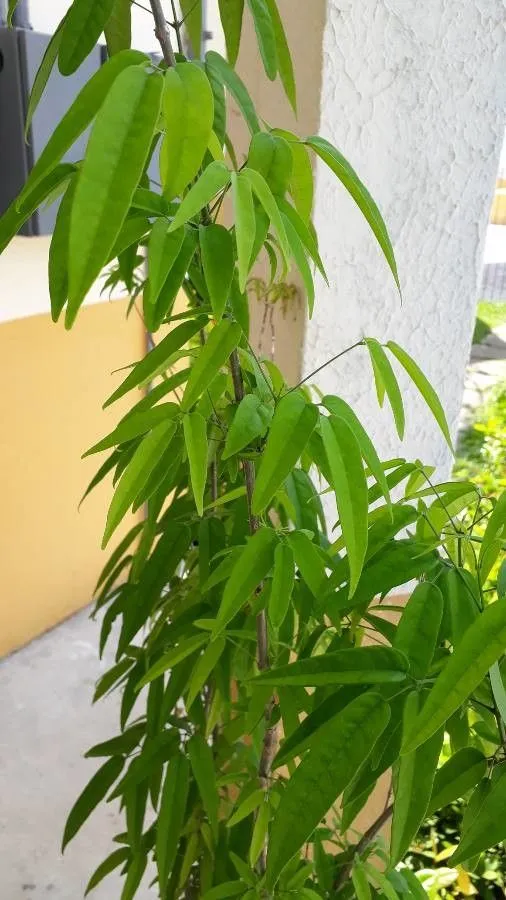
Author: (Bonpl.) L.G.Lohmann
Bibliography: Ann. Missouri Bot. Gard. 99: 434 (2014)
Year: 2014
Status: accepted
Rank: species
Genus: Fridericia
Vegetable: False
Observations: C. Mexico to Trop. America
Nestled within the vibrant canopy of tropical America and extending northwards to Central Mexico, the delightful Cricketvine, scientifically known as Fridericia chica, paints a picturesque scene with its radiant foliage and charming structure. This member of the Bignoniaceae family is a delightful addition to the myriad of botanical wonders cherished by nature enthusiasts and horticulturists alike.
The distinguishing allure of Fridericia chica lies in its symphony of verdant leaves and delicate flowers. This climber showcases heart-shaped leaves that can be a marvel of bright, lush green shades, embodying the vitality of the ecosystems it thrives in. The Cricketvine exhibits resilience and adaptability, making it a vital component of the floral framework in its native habitats.
Fridericia chica spans a wide geographical range, from the tropical expanses of Central and South America up to the diverse landscapes of Central Mexico. Its presence in these regions exemplifies its adaptability and ecological significance. Serving as a bioindicator, Cricketvine underscores the health of its surrounding environment, thriving in settings that support rich biodiversity and offering a refuge for numerous species within its foliage.
The botanical marvel of Fridericia chica has garnered notable scientific attention. A comprehensive review and recognition of this plant were documented in the Annals of the Missouri Botanical Garden in 2014, specifically within volume 99, page 434. This detailed assessment solidified its standing within the scientific community, thanks in part to the diligent research and observations that have provided valuable insights into its characteristics and ecological contributions.
The scientific nomenclature of Fridericia chica attributes to (Bonpl.) L.G. Lohmann, acknowledging the contributions of two leading botanists. Their work ensures that the Cricketvine is classified correctly within the broader taxonomy of plants. This recognition not only underscores the historical journey of this plant’s discovery and classification but also highlights the ongoing botanical studies that continue to enrich our understanding of the natural world.
In summary, the Cricketvine, or Fridericia chica, stands as a botanical gem within the Bignoniaceae family. Its lush foliage, ecological significance, and broad geographical presence highlight its importance both as a natural wonder and as a subject of scientific inquiry. As it continues to be a point of study and admiration, the legacy of Fridericia chica will undoubtedly hold a cherished place in the annals of botanical history.
Por: cajuru, carajiru, carajunu, carajuru, chica, china, cipó-cruz, cipó-pau, coá-piranga, crajiru, crajuru, cuica, guajuru, guajuru-piranga, guarajuru, oajuru, oajuru-piranga, paripari, pariri, piranga
Eng: cricketvine
En: Cricketvine
Pt: Cajuru, Carajiru, Carajunu, Carajuru, Chica, China, Cipó-cruz, Cipó-pau, Coá-piranga, Crajiru, Crajuru, Cuica, Guajuru, Guajuru-piranga, Guarajuru, Oajuru, Oajuru-piranga, Paripari, Pariri, Piranga
Taken Apr 20, 2015 by Nelson Zamora Villalobos (cc-by-nc)
Taken Apr 23, 2015 by Nelson Zamora Villalobos (cc-by-nc)
Taken Apr 23, 2015 by Nelson Zamora Villalobos (cc-by-nc)
Taken Apr 20, 2015 by Nelson Zamora Villalobos (cc-by-nc)
Taken Apr 20, 2015 by Nelson Zamora Villalobos (cc-by-nc)
Taken Oct 15, 2019 by Nelson Zamora Villalobos (cc-by-nc)
Taken Jan 4, 2022 by Alceu Ferrari (cc-by-sa)
Taken Apr 22, 2021 by GilmaraFrança (cc-by-sa)
Taken Oct 15, 2021 by Costa Patrícia (cc-by-sa)
Taken Sep 24, 2021 by Costa Patrícia (cc-by-sa)
Taken Sep 17, 2021 by pereira Humberto (cc-by-sa)
Taken Oct 15, 2019 by Nelson Zamora Villalobos (cc-by-nc)
Taken Oct 15, 2019 by Nelson Zamora Villalobos (cc-by-nc)
© copyright of the Board of Trustees of the Royal Botanic Gardens, Kew.
© copyright of the Board of Trustees of the Royal Botanic Gardens, Kew.
© copyright of the Board of Trustees of the Royal Botanic Gardens, Kew.
Family: Myrtaceae Author: (F.Muell.) K.D.Hill & L.A.S.Johnson Bibliography: Telopea 6: 402 (1995) Year: 1995 Status:…
Family: Rubiaceae Author: Pierre ex A.Froehner Bibliography: Notizbl. Bot. Gart. Berlin-Dahlem 1: 237 (1897) Year:…
Family: Sapindaceae Author: Koidz. Bibliography: J. Coll. Sci. Imp. Univ. Tokyo 32(1): 38 (1911) Year:…
Family: Asteraceae Author: A.Gray Bibliography: Pacif. Railr. Rep.: 107 (1857) Year: 1857 Status: accepted Rank:…
Family: Fabaceae Author: Medik. Bibliography: Vorles. Churpfälz. Phys.-Ökon. Ges. 2: 398 (1787) Year: 1787 Status:…
Family: Aspleniaceae Author: (Cav.) Alston Bibliography: Bull. Misc. Inform. Kew 1932: 309 (1932) Year: 1932…